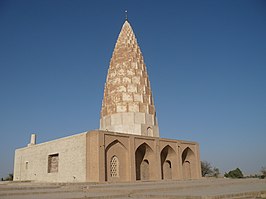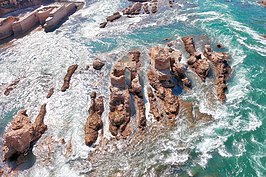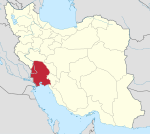City in Khuzestan, Iran
| Dezful Persian: دزفول | |
|---|---|
| City | |
   | |
| Nicknames: دسفیل ,دژپل, desfeal, dezhpoll | |
 | |
| Coordinates: 32°22′43″N 48°24′52″E / 32.37861°N 48.41444°E / 32.37861; 48.41444 | |
| Country | Iran |
| Province | Khuzestan |
| County | Dezful |
| District | Central |
| Elevation | 150 m (490 ft) |
| Population | |
| • Urban | 264,709 |
| • Metro | 443,971 |
| Time zone | UTC+3:30 (IRST) |
| Area code | 061 |
Dezful (Persian: دزفول; pronounced [dɛzˈfuːl]) is a city in the Central District of Dezful County, Khuzestan province, Iran, serving as capital of both the county and the district.
History
Dezful is one of the oldest cities in the Khuzestan province. According to Walther Hinz excavations, Awan (capital of the first Elam empire) was located in Dezful.
The name Dezfūl is believed to be associated with a Sasanian bridge constructed over the Āb-e Dez by Šāpūr II. The Sasanians also built a fortress in close proximity to protect the bridge. This area, encompassing the bridge and the fortress, eventually evolved into the city of Dež-Pol or Dezfūl, although this name was not commonly used until the 12th century. In the 10th century, the writer Eṣṭaḵrī referred to it as Qanṭarat-al-Andāmeš. It was also known as Qaṣr al-Rūnāš. The stone foundation of the bridge is still visible, while the upper part underwent several brick reconstructions during the early Islamic, Saljuq, and Qajar periods. In the 14th century, Ḥamd-Allāh Mostāwfī described it as 520 paces long and 15 paces wide, with forty-two arches. Šaraf-al-Dīn Yazdī, who visited the area in 795/1393, also provided a detailed description.
According to George Curzon, who visited the area in the late 19th century, the principal local industry in Dezfūl was indigo, with 120 factories in the town. The cultivation of indigo was introduced in the early 19th century. Dezfūl was also renowned for its fine reed pens.
Etymology
The name Dezful has been derived from the two words dej (fortress) + pul (bridge), which in combination could stand for 'the bridge to the fortress' or 'fortified bridge' in Persian language. The original name of the city was Dezhpul, but after the Muslim conquest of Persia, the city was renamed Dezful, since the Arabic language does not have 'p' and 'zh' sounds.The city is also known as Dizful and Desful.
Demographics
Language
The people of Dezful, known as Dezfuli, Dezfoolian or Dezfulian, speak Persian dialects of Dezfuli – a dialect distinct to Dezful – and Shushtari, a dialect of Shushtar that is sometimes considered to be one of the most archaic Persian dialects. These dialects belong to the Southwest Iranian language group. However, they differ significantly from standard Persian in terms of pronunciation, word formation, and vocabulary. The most notable distinctions are found in the structure of verbs. Although they share some similarities with nearby Lor dialects, they are still distinct. The differences between Dezfuli and Shushtari are mainly a result of variations in the detailed sound patterns of the language.
Historically, Dezful was home to a Mandaean community for many centuries. One of Dezful's best-known residents was the Mandaean priest Ram Zihrun.
Population
At the time of the 2006 National Census, the city's population was 228,507 in 55,711 households. The following census in 2011 counted 248,380 people in 66,715 households. The 2016 census measured the population of the city as 264,709 people in 78,348 households.
Geography
Dezful is 650 kilometers away from the national capital of Tehran and 155 kilometres away from the provincial capital of Ahvaz. The city is located 300 kilometres from the Persian Gulf and is at an altitude of 143 meters.
The city lies at the foot of the Zagros Mountains and has a history that dates back to the Sassanian era. The area around Dezful has been home to civilizations for 5000 years.
Dezful sits close to the foothills of the Zagros Mountains on the main north-south highway from Tehran to Ahvaz, the provincial capital of Khuzestan. The main rail line from Tehran to the Persian Gulf is 15 km (9 mi) from Dezful, on the opposite side of the Dez River.
Climate
Dezful has a hot semi-arid climate (Köppen climate classification BSh) with extremely hot summers and mild winters. Rainfall is higher than most of southern Iran, but is almost exclusively confined to the period from November to April, though on occasions it can exceed 250 millimetres (9.8 in) per month or 600 millimetres (24 in) per year.
Snowfall in this city is a very rare event. But in 2020, for the first time, the city of Dezful witnessed snowfall, which led to the happiness of the people
| Climate data for Dezful | |||||||||||||
|---|---|---|---|---|---|---|---|---|---|---|---|---|---|
| Month | Jan | Feb | Mar | Apr | May | Jun | Jul | Aug | Sep | Oct | Nov | Dec | Year |
| Record high °C (°F) | 28.0 (82.4) |
29.0 (84.2) |
36.0 (96.8) |
40.5 (104.9) |
48.4 (119.1) |
50.7 (123.3) |
53.6 (128.5) |
52.0 (125.6) |
49.8 (121.6) |
43.0 (109.4) |
35.0 (95.0) |
29.0 (84.2) |
53.6 (128.5) |
| Mean daily maximum °C (°F) | 17.2 (63.0) |
19.6 (67.3) |
24.1 (75.4) |
30.0 (86.0) |
37.5 (99.5) |
43.7 (110.7) |
46.0 (114.8) |
44.9 (112.8) |
41.7 (107.1) |
34.8 (94.6) |
26.2 (79.2) |
19.3 (66.7) |
32.1 (89.8) |
| Daily mean °C (°F) | 10.8 (51.4) |
13.2 (55.8) |
17.3 (63.1) |
22.8 (73.0) |
29.9 (85.8) |
35.1 (95.2) |
37.0 (98.6) |
35.8 (96.4) |
32.0 (89.6) |
25.6 (78.1) |
17.9 (64.2) |
12.5 (54.5) |
24.2 (75.5) |
| Mean daily minimum °C (°F) | 5.3 (41.5) |
6.8 (44.2) |
10.0 (50.0) |
14.7 (58.5) |
20.5 (68.9) |
23.8 (74.8) |
26.2 (79.2) |
25.5 (77.9) |
21.1 (70.0) |
16.2 (61.2) |
10.8 (51.4) |
6.8 (44.2) |
15.6 (60.2) |
| Record low °C (°F) | −9 (16) |
−4.0 (24.8) |
−2 (28) |
3.0 (37.4) |
10.0 (50.0) |
16.0 (60.8) |
19.0 (66.2) |
16.5 (61.7) |
10.0 (50.0) |
6.0 (42.8) |
1.0 (33.8) |
−2 (28) |
−9 (16) |
| Average rainfall mm (inches) | 100.6 (3.96) |
60.0 (2.36) |
50.2 (1.98) |
34.5 (1.36) |
9.2 (0.36) |
0.0 (0.0) |
0.2 (0.01) |
0.0 (0.0) |
0.0 (0.0) |
7.4 (0.29) |
39.1 (1.54) |
83.2 (3.28) |
384.4 (15.14) |
| Average rainy days | 9.9 | 8.1 | 8.1 | 6.5 | 3.0 | 0.0 | 0.1 | 0.0 | 0.0 | 2.1 | 6.2 | 8.0 | 52 |
| Average relative humidity (%) | 75 | 68 | 59 | 49 | 32 | 22 | 24 | 28 | 29 | 40 | 59 | 73 | 47 |
| Mean monthly sunshine hours | 131.6 | 158.4 | 192.3 | 217.7 | 272.5 | 325.6 | 322.7 | 317.0 | 291.3 | 234.8 | 158.2 | 121.9 | 2,744 |
| Source: NOAA (1961-1990) | |||||||||||||
Economy
Sugarcane, which has been cultivated in the Dezfūl region for more than a thousand years, is still an important economic factor; a modern sugar refinery with a capacity of more than 300 tons has been built in Haft Tappa near the town of Dezfūl. Other major agricultural products of the šahrestān include wheat, barley, clover, alfalfa, sesame, maize, and grass peas; sheep are the most important livestock
Artisan work
The Dezful reed pen is one of the important commercial products that has been cultivated in Dezful for the past three hundred years and is recognized as the finest reed pen at the national and global levels . In the past, the Dezful reed pen was exported to countries like Turkey and China, and it is still exported to most cities in Iran.
Dezful is also known for its handmade wooden tools, including hookah bases, hookahs, candlesticks, coat hangers, and salt shakers. Additionally, the city's handicraft traditions encompass metalwork, such as varshoosazi (crafting items from a Nickle Silver), engraving on gold and silver, and goldsmithing.
In the varshoosazi workshops of Dezful's old bazaar, artisans craft tools for tea drinking and other purposes. The craft of varshoosazi (the making of varsho items) in Iran dates back to the Safavid era, but its peak occurred during the Qajar period and continued into the Pahlavi dynasty. Varsho metal sheets, also known as German silver or Nickle Silver, were imported from Germany, particularly from Poland. This is why Iranian artisans named the metal varsho(Warsaw), after the city of Warsaw, the capital of Poland, and the craft became known as varshoosazi. Artisans from Isfahan, Borujerd, and Dezful were the first to learn how to produce varsho crafts by observing Russian samovars and other products. The varshoosazi industry reached its height in Iran, particularly in the cities of Dezful and Borujerd, during the late Qajar and early Pahlavi periods. Many individuals adopted the surname Varshoochi or Varshabi in Dezful because it was closely associated with their profession as varsho craftsmen.
Higher Education
Dezful is home to various higher education institutions, each offering various academic and professional programs. These institutions have played an integral role in promoting education, research, and professional development in khuzetsan, significantly contributing to Dezful's academic and cultural richness.
- Dezful University of Medical Sciences
- Jundi-Shapur University of Technology (Dezful)
- Islamic Azad University of Dezful
- University of Applied Science and Technology (Dezful Applied Science and Technology Center)
- Payame Noor University of Dezful
- Khadijeh Kobra Higher Education Center (Farhangian University)
- Sheikh Morteza Ansari Higher Education Center (Farhangian University)
Historical monuments

In an area with a history that extends back to ancient civilization, the city houses a bridge that dates back to 300 AD.
Transportation
There are direct flights from Tehran to Dezful (and reverse) at least twice a day. There are also weekly flights from Dezful to Mashhad (mawhad or mašhad). Dezful can also be reached by the Iranian railways.
Buses are available from almost all Iranian major cities to Dezful or one of its adjacent cities. Trains of the Trans-Iranian Railway serve the neighboring town of Andimeshk.
Twin towns – sister cities
 Tyre, Lebanon
Tyre, Lebanon
Contemporary people
- Abdulrahman Nafisi (1948-1990), bank manager
See also
- Battle of Dezful
- Morteza Ansari (1781–1864), a famous Shia jurisprudent
- Gholam Ali Rashid (born 1953), Iranian commander from Dezful
Notes
- Dezfuli dialect: Desfil, pronounced [desˈfiːl]); also romanized as Dezfool and Dezfūl; also known as Ab-e Diz and Dīzfūl
References
- OpenStreetMap contributors (18 December 2024). "Dezful, Dezful County" (Map). OpenStreetMap (in Persian). Retrieved 18 December 2024.
- ^ Census of the Islamic Republic of Iran, 1395 (2016): Khuzestan Province. amar.org.ir (Report) (in Persian). The Statistical Center of Iran. Archived from the original (Excel) on 21 October 2020. Retrieved 19 December 2022.
- "Burujird" . Encyclopædia Britannica. Vol. 04 (11th ed.). 1911.
- Dezful can be found at GEOnet Names Server, at this link, by opening the Advanced Search box, entering "-3061127" in the "Unique Feature Id" form, and clicking on "Search Database".
- Habibi, Hassan (26 July 2014) . Approval of the organization and chain of citizenship of the elements and units of the national divisions of Khuzestan province, centered in the city of Ahvaz. rc.majlis.ir (Report) (in Persian). Ministry of the Interior, Political and Defense Commission of the Government Board. Proposal 3233.1.5.53; Letter 907-93808; Notification 82830/T126K. Archived from the original on 17 July 2014. Retrieved 25 January 2024 – via Islamic Parliament Research Center.
- "Welcome to Encyclopaedia Iranica".
- "Welcome to Encyclopaedia Iranica".
- "Welcome to Encyclopaedia Iranica".
- ^ "اخبار استان های ایران". www.dezfulshenasi.mihanblog.com. Archived from the original on 21 April 2018. Retrieved 2 April 2018.
- Everett-Heath, John (24 October 2019). The Concise Oxford Dictionary of World Place Names. Oxford University Press. doi:10.1093/acref/9780191882913.001.0001. ISBN 978-0-19-188291-3.
- The Columbia Encyclopedia Columbia Press. The Columbia Encyclopedia. ISBN 9781786848468.
- "DEZFŪLĪ AND ŠŪŠTARĪ DIALECTS Welcome to Encyclopaedia Iranica".
- Buckley, Jorunn Jacobsen (2002). The Mandaeans: ancient texts and modern people. New York: Oxford University Press. ISBN 0-19-515385-5. OCLC 65198443.
- Buckley, Jorunn Jacobsen (2010). The great stem of souls: reconstructing Mandaean history. Piscataway, N.J: Gorgias Press. ISBN 978-1-59333-621-9.
- Census of the Islamic Republic of Iran, 1385 (2006): Khuzestan Province. amar.org.ir (Report) (in Persian). The Statistical Center of Iran. Archived from the original (Excel) on 20 September 2011. Retrieved 25 September 2022.
- Census of the Islamic Republic of Iran, 1390 (2011): Khuzestan Province. irandataportal.syr.edu (Report) (in Persian). The Statistical Center of Iran. Archived from the original (Excel) on 18 January 2023. Retrieved 19 December 2022 – via Iran Data Portal, Syracuse University.
- ""دزفول" شهری از سپیده دم تاریخ".
- "اداره کل هواشناسی استان چهارمحال و بختیاری". www.chaharmahalmet.ir. Retrieved 2 April 2018.
- "بارش برف در خوزستان مردم را غافلگیر کرد - تسنیم". خبرگزاری تسنیم | Tasnim (in Persian). Retrieved 29 February 2024.
- "Dezful Climate Normals 1961-1990". National Oceanic and Atmospheric Administration. Retrieved 28 December 2012.
- MASSOUD KHEIRABADI, "DEZFŪL i. Geography," Encyclopædia Iranica, online edition, 2015, '>MASSOUD KHEIRABADI. DEZFŪL i. Geography," Encyclopædia Iranica.
- Sina Goudarzi and Bahram Grami. "QALAM".
- "Nickel Silver Crafts; Traditional Art in Western Iran". 31 March 2018.
- KARAMIAN, Gholamreza (2020). "Historical Metal works named Warsaw in Iran". Historia i Świat. 9 (9): 205–218. doi:10.34739/his.2020.09.15. hdl:11331/3066.
- سايت اداره ميراث فرهنگي ، صنايع دستي و گردشگري شهرستان دزفول Archived 2008-10-13 at the Wayback Machine
- "خبرگزاری صداوسیما | IRIB News". Archived from the original on 10 June 2015. Retrieved 16 November 2013.
Sources
External links
- Persian Language and Dezful Tourism Archived 24 February 2020 at the Wayback Machine
- Azarkish Dezful
- Dezful Tourism Archived 11 August 2020 at the Wayback Machine
- Dezful News Network Archived 17 January 2021 at the Wayback Machine
- Dezful Magazine Archived 14 May 2021 at the Wayback Machine
- Dezful Unofficial Website
| Khuzestan province, Iran | ||
|---|---|---|
| Capital |  | |
| Counties and cities | ||
| Sights |
| |
| Populated places | ||